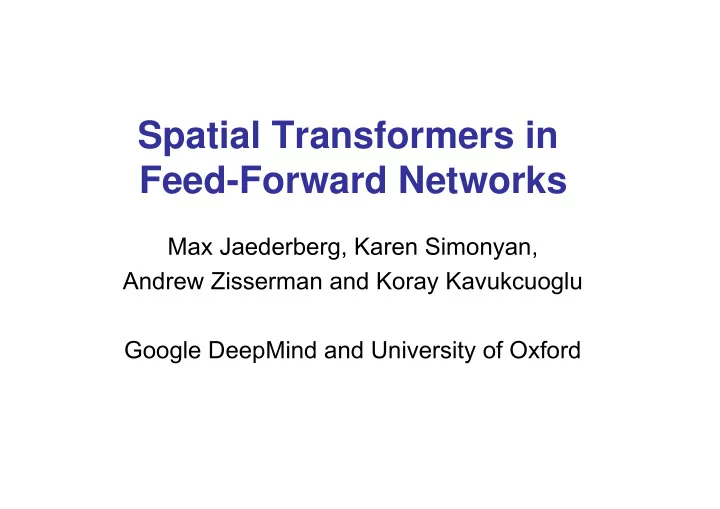

Spatial Transformers in Feed-Forward Networks Max Jaederberg, Karen Simonyan, Andrew Zisserman and Koray Kavukcuoglu Google DeepMind and University of Oxford
ConvNets • Interleaving convolutional layers with max-pooling layers allows translation invariance. - Pooling is simplistic. - Only small invariances per pooling layer - Limited spatial transformation - Pools across entire image + Exceptionally effective • Can we do better?
Motivation 1: transformations of input data Rotated MNIST (+/- 90°)
Motivation 2: attention
Conditional Spatial Warping • Conditional on input featuremap, spatially warp image. + Transforms data to a space expected by subsequent layers + Intelligently select features of interest (attention) + Invariant to more generic warping transform transform
Conditional Spatial Warping network Spatial output input transform er
A differentiable module for spatially transforming data, conditional on the data itself Grid Localisation net generator V U Sampler Spatial Transformer
Sampling Grid Warp regular grid by an affine Can parameterise, e.g. affine transformation transformation ⎛ ⎞ # ⎛ ⎞ Ã ! " x t x t i i x s θ 11 θ 12 θ 13 ⎜ ⎟ ⎜ ⎟ i y t y t = T θ ( G i ) = A θ ⎠ = ⎝ ⎝ ⎠ i i y s θ 21 θ 22 θ 23 i 1 1 V U
Sampling Grid Warp regular grid by an affine Can parameterise attention transformation ⎛ ⎞ ⎛ ⎞ Ã ! x t x t · ¸ i i x s ⎜ ⎟ s 0 t x ⎜ ⎟ i y t y t = T θ ( G i ) = A θ ⎠ = ⎝ ⎝ ⎠ i i y s 0 s t y i 1 1 V U
Identity affine transformation transformation
Sampler Sample input featuremap U to produce output feature map V (i.e. texture mapping) e.g. for bilinear interpolation: H W X X V c U c nm max(0 , 1 − | x s i − m | ) max(0 , 1 − | y s i − n | ) i = n m and gradients are defined to allow backprop, eg: H W X X ∂ V c V U i max(0 , 1 − | x s i − m | ) max(0 , 1 − | y s i − n | ) = ∂ U c nm n m
A differentiable module for spatially transforming data, conditional on the data itself Grid Localisation net generator V U Sampler Spatial Transformer
Spatial Transformer Networks • Spatial Transformers is differentiable, and so can be inserted at any point in a feed forward network and trained by back propogration = Example: • digit classification, loss: cross-entropy for 10 way classification 0 0 CNN CNN ST 9 9
MNIST Digit Classification Training data: 6000 examples of each digit Testing data: 10k images Can achieve testing error of 0.23%
Task: classify MNIST digits • Training and test randomly rotated by (+/- 90°) • Fully connected network with affine ST on input Spatial network output transformer input Performance: • FCN 2.1 • CNN 1.2 • ST-FCN 1.2 • ST-CNN 0.7
Generalizations 1: transformations • Affine transformation – 6 parameters • Projective transformation – 8 parameters • Thin plate spline transformation • Etc Any transformation where parameters can be regressed
Rotated MNIST ST-FCN Affine ST-FCN Thin Plate Spline Input ST Output Input ST Output 7 7 3 6 2 2 9 7 7 8
Rotated, Translated & Scaled MNIST ST-FCN Projective ST-FCN Thin Plate Spline Input ST Output Input ST Output 9 6 0 7 5 3 8 1 5 7
Translated Cluttered MNIST ST-FCN Affine ST-CNN Affine Input ST Output Input ST Output 6 5 3 1 5 2 5 4 6 4
Results on performance R: rotation P: projective RTS: rotation, translation, scale E: elastic
Generalization 2: Multiple spatial transformers • Spatial Transformers can be inserted before/after conv layers, before/after max-pooling • Can also have multiple Spatial Transformers at the same level = 0 conv3 ST2a conv2 conv1 ST3 9 ST1 ST2b
Task: Add digits in two images MNIST digits under rotation, translation and scale Architecture
Task: Add digits in two images input (2 channels) MNIST 2-channel addition chan1 chan2 Add up the digits. One per channel. Random per-channel rotation, scale and translation. SpatialTransformer1 SpatialTransformer2 SpatialTransformer1 automatically specialises to rectify channel 1. SpatialTransformer2 automatically specialises to rectify channel 2. chan1 chan2 chan1 chan2
Task: Add digits in two images MNIST digits under rotation, translation and scale Performance % error
Applications and comparisons with the state of the art
Street View House Numbers (SVHN) 200k real images of house numbers collected from Street View Between 1 and 5 digits in each number 2 2 Architecture: 2 …. fc3 null conv2 conv1 null ST2 ST1 4 spatial transformer + conv layers, 4 conv layers, 3 fc layers, 5 character output layers
SVHN 64x64 • CNN: 4.0% error • (single model) Goodfellow et al 2013 • Attention: 3.9% error • (ensemble with MC averaging) Ba et al, ICLR 2015 • ST net: 3.6% error • (single model)
SVHN 128x128 • CNN: 5.6% error • (single model) • Attention: 4.5% error • (ensemble with MC averaging) Ba et al, ICLR 2015 • ST net: 3.9% error • (single model)
Fine Grained Visual Categorization CUB-200-2011 birds dataset • 200 species of birds • 6k training images • 5.8k test images
Spatial Transformer Network • Pre-train inception networks on ImageNet • Train spatial transformer network on fine grained multi-way classification
CUB Performance
Summary ● Spatial Transformers allow dynamic, conditional cropping and warping of images/feature maps. ● Can be constrained and used as very fast attention mechanism. ● Spatial Transformer Networks localise and rectify objects automatically. Achieve state of the art results. ● Can be used as a generic localisation mechanism which can be learnt with backprop.
Recommend
More recommend